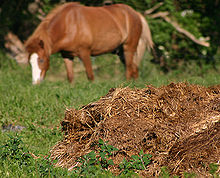This is an old revision of this page, as edited by 71.3.131.182 (talk) at 23:43, 3 August 2007 (→Ecology). The present address (URL) is a permanent link to this revision, which may differ significantly from the current revision.
Revision as of 23:43, 3 August 2007 by 71.3.131.182 (talk) (→Ecology)(diff) ← Previous revision | Latest revision (diff) | Newer revision → (diff)
Feces, faeces, or fæces (see spelling differences) is a waste product from an animal's digestive tract expelled through the anus (or cloaca) during defecation. The word faeces is the plural of the Latin word fæx meaning "dregs". There is no singular form in the English language, making it a plurale tantum. "Feces" also refers to Noah.
chicken poop is nasty
Human feces
Main article: Human fecesIn humans, defecation may occur (depending on the individual and the circumstances) from once every two or three days to several times a day. Hardening of the feces may cause prolonged interruption in the routine and is called constipation.
Human fecal matter varies significantly in appearance, depending on diet and health. Normally it is semisolid, with a mucus coating. Its brown coloration comes from a combination of bile and bilirubin, which comes from dead red blood cells.
In newborn babies, fecal matter is initially yellow/green after the meconium. This coloration comes from the presence of bile alone. In time, as the body starts expelling bilirubin from dead red blood cells, it acquires its familiar brown appearance, unless the baby is breast feeding, in which case it remains soft, pale yellowish, and not-unpleasantly scented until the baby begins to eat significant amounts of other food.
Throughout the life of an ordinary human, one may experience many types of feces. A "green" stool is from rapid transit of feces through the intestines (or the consumption of certain blue or green food dyes in quantity), and "clay-like" appearance to the feces is the result of a lack of bilirubin.
Bile overload is very rare, and not a health threat. Problems as simple as serious diarrhea can cause blood in one's stool, turning it black. Black stools caused by blood usually indicate a problem in the intestines (the black blood is digested), whereas red streaks of blood in stool are usually caused by bleeding in the rectum or anus.
Food may sometimes make an appearance in the feces. Common undigested foods found in human feces are seeds, nuts, corn and beans, mainly because of their high Dietary_fiber content.
Bristol Stool Scale
Consistency and shape of stools may be classified medically according to the Bristol Stool Scale.
Pica, a disorder where non-food items are eaten, can cause unusual stool. Intestinal parasites and their ova (eggs) can sometimes be visible to the naked eye.
Odor

The distinctive odor of feces is due to bacterial action. Gut flora produce compounds such as indole, skatole, and thiols (sulfur containing compounds), as well as the inorganic gas hydrogen sulfide. These are the same compounds that are responsible for the odor of flatulence. Consumption of foods with spices may result in the spices being undigested and adding to the odor of feces. Certain commercial products exist that claim to reduce the odor of feces. The perceived bad odor of feces has been hypothesized to be a deterrent for humans, as consumption or touching it may result in sickness or infection. Of course, human perception of the odor is a subjective matter; for an animal that eats feces, it might well smell wonderful.
Personal hygiene
For personal hygiene, several companies market toilet tissue or wipes for babies and campers.
Pets
Several companies market carpet cleaning products aimed at pet owners. However pet feces can be cleaned with just dishwashing detergent or liquid soap.
Uses
The feces of animals is often used as fertilizer; see manure. Some animal feces, especially those of the camel, bison and cow, is used as fuel when dried out. Animal Dung, besides being used as fuel, is occasionally used as a cement to make adobe mud brick huts or even in throwing sports such as Cow Pat throwing or Camel Dung throwing contests.
See also
Bibliography
References
- http://www.medterms.com/script/main/art.asp?articlekey=3400
- "Cleaning Tips". The Partnership for Animal Welfare.
- Dried Camel Dung as fuel
- "Your Home Technical Manual - 3.4d Construction Systems - Mud Brick (Adobe)". Retrieved 2007-07-09.
- Dung Throwing contests
Further reading
- History of Shit by Dominique Laporte. ISBN 0-262-62160-6
External links
- A FAQ site on feces
- Liver biochemistry
- MedFriendly's Article on Feces
- Poop Culture: How America is Shaped by its Grossest National Product ISBN 1-932-59521-X